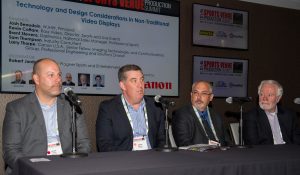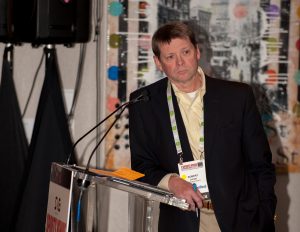Sports Venue Production Summit: Creative Solutions — Some Built From Scratch — Power Latest LED Video Displays
Leaders in production and use of in-venue displays discuss the tech and design
Story Highlights
As sports-venue owners and architects look to push the boundaries of video-display design and move beyond the confines of 16:9, those charged with building and powering the displays must figure out how to turn concept into reality. At SVG’s recent Sports Venue Production Summit at Mercedes-Benz Stadium in Atlanta, leaders involved in some of the country’s unique and most eye-catching video displays discussed their current technological and design considerations and what to expect in the future.
Of course, with the event taking place at Mercedes-Benz Stadium, all eyes were on the stadium’s massive, 360-degree Halo board throughout the event. But, the panelists agreed, a 360-degree display isn’t the only “non-traditional” use of LED.

From left: Ross Video’s Kevin Cottam, Daktronics’ Brent Stevens, Industry consultant Sam Thompson, and Canon USA’s Larry Thorpe
“On the LED side, when you look out at the bowl and you look at the Halo, the size is always getting bigger,” said Brent Stevens, national sales manager, professional sports, Daktronics. “[We’re also] starting to get into club spaces, where, instead of using traditional screens, they’re using LED. It’s really trying to figure out, as the technology that we’re creating is getting smaller and tighter, where can we use it and how can we use it in a way that typically, in the past, has been monitors or a blank concrete wall.”
As he noted, LED continues to find its way into spaces where, traditionally, there were no displays. Fitting LED displays into unique areas of the venue is only half the battle, however. The question then becomes, how do you power it?
“When we say ‘non-traditional’ or ‘non-standard’ displays, what does that even mean?” said Kevin Cottam, director, sports and live events, Ross Video, referring to the title of the panel, Technology and Design Considerations in Non-Traditional Video Displays. “If you’re talking LED, [venues often] find a hole or a space somewhere and fill it with LED. Then they figure out how to drive it.”
Four years before Mercedes-Benz Stadium even opened its doors, Ross Video was involved with figuring out how to drive the stadium’s now iconic Halo. The solution was to develop a new system called Tessera, which enables users to link multiple XPression engines together to create a scalable matrix of channels for seamless output on the 360-degree canvas.
“We start looking at every project as a custom build,” Cottam noted, “and [figure out] how to use a traditional toolset to drive these monster displays that are getting tighter pixel resolution. The challenge is, it’s always custom. [What’s essential is] the toolset and the experience and the space to be able to keep building on past projects and move forward with new technologies and be able to push that technology forward to newer and larger displays.”
Before the Halo, however, the award for unique, most eye-catching display — and most complex video-production workflow — had to go to the Jacksonville Jaguars’ 8K display at EverBank Field. Industry consultant Sam Thompson, who directs the Jaguars’ video presentation on game day, weighed in on the challenges his team faced when confronting an 8K board.
“When you’re dealing with non-traditional, think about trying to make an 8K-wide video display — that’s 8,456 pixels wide — using technology from 2013, when 4K was just barely coming out,” he explained. “How do you build it, design it, but also use it? First you make the beast; then you have to make the beast run and run consistently, game in and game out.”
How to power these LED displays isn’t the only consideration. Sports venues must invest in the technology to capture the content that will feed a multitude of different displays and future-proof the workflow for the years ahead.
“I think people today are going to be buying cameras that are multiformat,” opined Larry Thorpe, senior fellow, Imaging Technologies and Communications Group, Professional Engineering and Solutions Division, Canon USA. “If this transition to 4K from HD spans a decade — and it might be something like that — you need something that’s ready to switch at any time. And a lens, which has a very, very long life — a decade or more — you need to be investing in a 4K lens today so you’re ready for [4K in the future].”
The panelists agreed that, when confronting a non-traditional display, communication between the venue owners and architects is key, as is looping in the production personnel who will be responsible for creating content for the display.
“On our end, [we need] access to the design team — from the structural engineer to the architect who actually designed it — and working not only with that team but also through the production team,” said Stevens. “That’s one piece that we don’t get involved in early enough.”
According to WJHW Principal Josh Beaudoin, the project’s budget will continue to determine how far the boundaries will be pushed. For example, he said, Mercedes-Benz Stadium wanted a uniquely shaped videoboard and enlisted Ross Video to develop the product that would run it — a product that, prior to this project, did not exist.
“When you talk about what’s coming next, it boils down to what do people actually envision? What do they dream?” said Beaudoin. “This building wasn’t a consultant-driven or a technology-driven display. This came out of the mind of an artist. … The more of this we do, the more technology that comes along, the more money that gets spent, it gets bigger, it comes along faster, and it gets easier. When you look at it, it really boils down to, what will people dream, what can people afford, and after that the industry will provide it.”
Addressing the venue and team personnel in the audience, Cottam advised, “Keep going, keep striving, make it bigger, make it better. Keep coming up with innovative ideas. You folks are really the idea people; we’re the ones that figure out how to make your idea a reality.”

